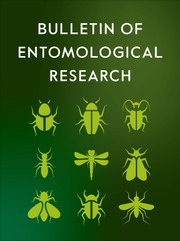No CrossRef data available.
Article contents
Unveiling the biocontrol potential of Harmonia axyridis: functional response to eggs of S. litura and S. frugiperda
Published online by Cambridge University Press: 09 October 2025
Abstract
Understanding predator-prey dynamics is pivotal for advancing sustainable pest management strategies. This study examined the functional response of Harmonia axyridis across six developmental stages when preying upon the eggs of two destructive lepidopteran pests including Spodoptera litura and Spodoptera frugiperda. Using logistic regression and Holling’s disc equation, a clear Type II functional response was observed across all stages except first instars, indicating a density-dependent predation pattern constrained by handling time at higher prey densities. Adult females consistently emerged as the most potent predators, demonstrating the highest effectiveness of predation (1.591 on S. litura; 1.736 on S. frugiperda) and maximum predation rates (113.7 and 120.9 eggs, respectively). Adult males and fourth instar larvae also showed high predation capacities, with maximum consumption nearing 99 and 95 eggs. In contrast, first instars exhibited minimal predatory potential (effectiveness <0.017; maximum consumption <10 eggs), highlighting the critical role of developmental maturity in predation performance. Notably, predation on S. frugiperda eggs slightly surpassed that on S. litura, suggesting host-specific traits may modulate predator efficiency. The functional response curves confirmed a classic decelerating intake rate at high prey densities, characteristic of Type II predators. These findings affirm the high consumptive potential of H. axyridis, particularly adult females, as efficient natural enemies against Spodoptera spp. eggs, and provide actionable insights for their integration into targeted, stage-specific biological control programs.
Information
- Type
- Research Paper
- Information
- Copyright
- © The Author(s), 2025. Published by Cambridge University Press.
Footnotes
These authors contributed equally to this paper.


